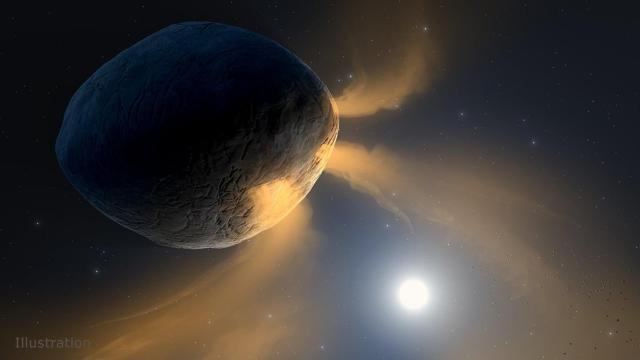A comet-like asteroid has been flaunting a tail of material as it approaches the Sun. But unlike its cometary counterparts, a fresh look at asteroid Phaethon reveals, this tail is made of sodium rather than dust, as was previously thought.
The Solar and Heliospheric Observatory (SOHO), a joint mission between NASA and the European Space Agency, recorded new observations of Phaethon as it passed near the Sun in May 2022. SOHO’s Large Angle and Spectrometric Coronagraph imaged the asteroid using different filters: one that detects dust and another that detects sodium.
In the recently captured images, the asteroid’s tail appears bright in the orange, sodium-sensitive filter, while not appearing in the blue, dust-detecting filter. This suggests that Phaethon’s tail is the result of the emission of sodium atoms rather than dust escaping the surface of the asteroid during its solar flyby. The findings are detailed in a paper published Tuesday in the Planetary Science Journal.

After seeing the asteroid’s short tail shine in the orange filter, the researchers behind the new study dug through old SOHO data to try to find more observations of Phaethon. They detected the asteroid in images dating back to more than 20 years ago.
“Our unique observing plan found the mysterious asteroid Phaethon for the first time in SOHO data,” Qicheng Zhang, PhD student at the California Institute of Technology and lead author of the paper, said in a statement by ESA. “By digging in the treasure chest of SOHO, we showed that Phaethon is visible in LASCO images from 18 different orbits back to 1997.”
Phaethon’s sodium tail adds even more mystery to this strange object. The asteroid was discovered in 1983 and named after the son of the Greek Sun god Helios for its close proximity to the star. Although classified as an asteroid, Phaethon has been showing some comet-like behaviour. The rock is the likely origin of the Geminid meteor shower, which streaks across the sky in December. Most meteor showers, however, are produced by comets as a trail of debris left behind during their solar flyby.
In 2009, NASA Solar Terrestrial Relations Observatory (STEREO) observed a short tail that trails behind Phaethon that appeared during the asteroid’s closest approach to the Sun during its 524-day orbit. Comets tend to form icy tails of dusty material as their surface ice vaporizes due to the heat of the star.
The discovery of sodium in Phaethon’s tail could also hold clues to the origin of its meteor shower. Scientists had previously thought that the asteroid’s tail is what crated the Geminid meteor shower, but the latest observations show that the asteroid doesn’t shed enough dust for the shower to form. Instead, the researchers behind the new study suggest that a piece of Phaethon broke off around a few thousand years ago, causing the asteroid to eject a stream of billions of bits that make up the Geminids.
Scientists are set to gather more data on Phaethon through an upcoming mission to the asteroid. The Japanese space agency is sending the DESTINY+ mission to the celestial body in 2028 in an attempt to image its surface.
